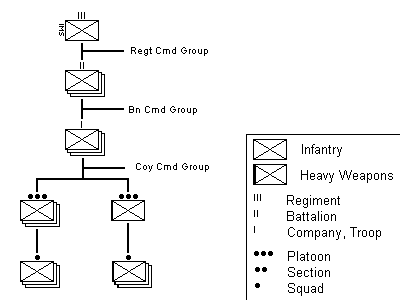

In 2301, IMS announced a major revision in the Table of Organization and Equipment (TO&E) for all of its ground military forces. This change was necessary due to changes in military doctrine and the renewed Kafer war offensive up the French Arm.
Under the new TO&E, the largest infantry unit remains a regiment in size, but the sub-unit composition has been changed slightly; with the major change being the reduction in basic squad size from ten to eight men. The binoms removed from the infantry squads have been reformed into heavy weapons squads, with one platoon per company. The new TO&E is explained below.
The standard infantry regiment contains 940 men, arranged into three battalions of 310 men and a regimental command group of ten men. Each battalion is comprised of three companies of 100 men each and a battalion command group of ten men. Each company contains a company command group of four men; three infantry platoons and a heavy weapons platoon; all of which contain twenty-four men. Each platoon contains three squads of eight men.
>Infantry regiments are classified by a numerical designation and the system in which they were formed, in the following format.
xxx Inf Regt (system)
Where xxx is a numerical designation for the regiment, and indicates the chronological order of formation of the regiments, commencing from 100 and system indicates the star system in which the regiment was mustered.
For example, the 101 Inf Regt (Sol) was the first infantry regiment to enter service with IMS, and was formed in the Sol system.
All squads within a platoon are numbered sequentially from 1 to 3. The platoons within the company are also numbered sequentially from 1 to 4, starting with the first infantry platoon and ending with the heavy weapons platoon. The companies are sequentially lettered from A to J (I is skipped) within the regiment. Identification is always written in the form squad, company, platoon, battalion.
Thus, a solider from the third squad of the fourth platoon of the first infantry company in the 639 Battalion of the 101 Infantry Regiment is identified as
34A/639 Bn, 101 Inf Regt (Sol)

As an infantry company is the largest unit typically fielded by IMS, it will be explained in more detail in the following paragraphs.
The fundamental unit of any IMS personnel ground force is the binom. The binom is the standard unit of the French ground forces; from which the concept has been borrowed. A binom is comprised of two men, one of which mans the key weapon for which the binom is named, and the other who is tasked with the defense of the key weapon operator. The non-key weapon perator is generally armed as a rifleman, although he usually carries additional ammunition for the key weapon operator and functions as his assistant. In a typical squad, this results in a minimum of four riflemen, with three to four key weapon operators. This has proved to be the most flexible composition while providing good overall offensive and defensive capabilities at the squad level. As well, eight man squads allows the squad to split into two fire teams of four men each, similar to the basic unit of the USMC, with only the personnel in the squad.
The infantry company is controlled by a four man company command group. This command group is comprised of two binoms, containing the company commander (Captain) and his RTO); and the company executive officer (Lieutenant) and his RTO.
Under the company command group are three infantry platoons and one heavy weapons platoon. Each platoon is comprised of three squads, with the platoon leader (Lieutenant) commanding both the platoon and the 1st squad. The platoon sergeant (Sergeant) commands the 2nd squad, and the squad sergeant (Sergeant) commands the 3rd squad.
Each infantry squad has four binoms: command, sniper, heavy weapons, and autofire. The command binom contains the squad leader and his RTO. The sniper binom contains a rifle marksman with a sniper designation and a rifleman. The heavy weapons binom contains the heavy weapons gunner who generally uses a PGMP, but may be armed with an anti-vehicle missile launcher as the situation warrants; and his assistant, a rifleman. The autofire binom contains the autofire gunner and his assistant, a rifleman.
Each heavy weapons squad also has four binoms: command, plasma, heavy autofire, and anti-vehicle. The command binom contains the squad leader and his RTO. The plasma binom contains the plasma gunner manning the heavy plasma gun and his assistant, a rifleman. The heavy autofire binom contains the autofire gunner and his assistant, a rifleman. The anti-vehicle binom contains the anti-vehicle gunner armed with an anti-vehicle missile launcher and his assistant, a rifleman.
When employed as mechanized infantry, the M24A3 AFV-APC is typically used for transport and additional fire support, as this allows the company command group to split into its two binoms and ride with the squads.
As of 2301, IMS has five Infantry Regiments at full operational strength, and one regiment with a strength of only one battalion.
These web pages developed and maintained by Terry A. Kuchta